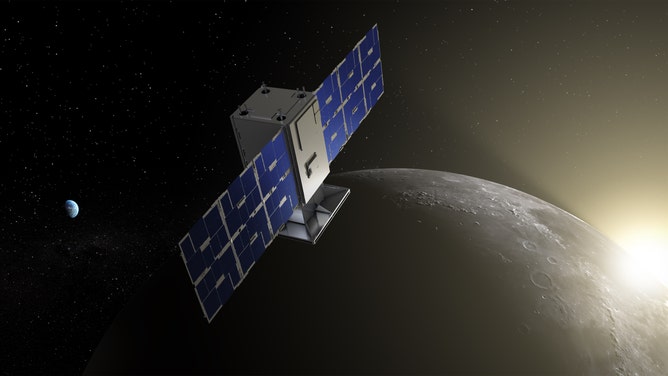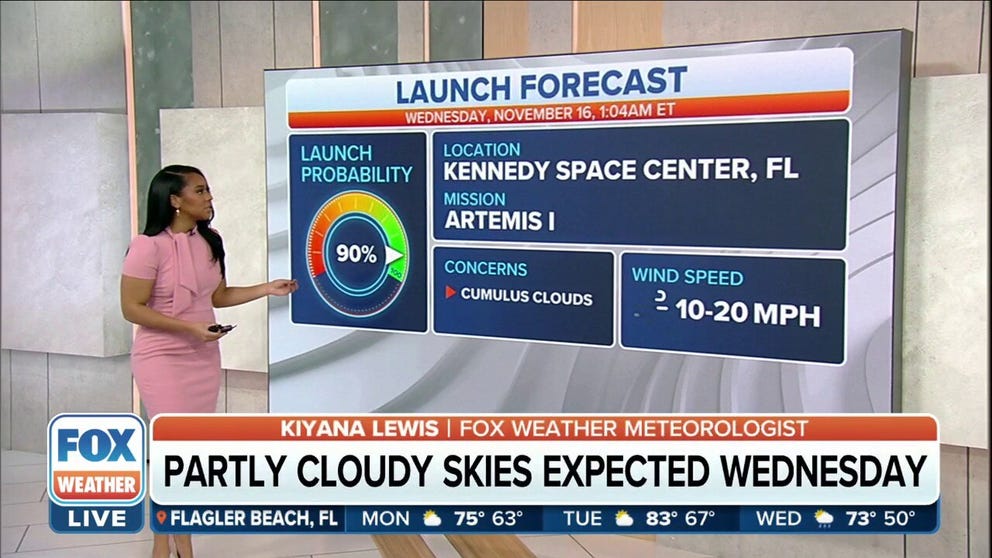NASA's CAPSTONE spacecraft arrives at the moon testing out special orbit for future human missions
NASA's microwave-size CAPSTONE spacecraft will test out navigating around the moon in a near-rectilinear halo orbit. The space agency plans to use the same specialized orbit for the lunar gateway, where astronauts will stop before heading down to the moon.

Artist rendering of CAPSTONE flying in cislunar space – the orbital space near and around the Moon. The mission will demonstrate an innovative spacecraft-to-spacecraft navigation solution at the Moon from a near rectilinear halo orbit slated for Artemis’ Gateway. (Credits: Illustration by NASA/Daniel Rutter)
(NASA)
A tiny NASA spacecraft arrived in a halo-like lunar orbit Sunday, providing a proving ground for future astronaut missions in the years ahead.
On Sunday around 5 p.m. Mountain time, the CAPSTONE spacecraft made its initial insertion into the Near Rectilinear Halo Orbit around the moon, according to Advanced Space, the company that manages the spacecraft for NASA.
NASA's microwave-size CAPSTONE spacecraft, which stands for Cislunar Autonomous Positioning System Technology Operations and Navigation Experiment, launched from New Zealand in June on Rocket Lab's Electron rocket and has been flying through space toward the moon over the past four months.
The spacecraft's arrival was announced Sunday night by NASA managers providing an update ahead of the Artemis 1 launch to the moon. The launch will be the first uncrewed test flight of NASA's SLS moon rocket and Orion spacecraft, designed to return humans to the lunar surface by 2025.
"CAPSTONE has arrived in a near-rectilinear halo orbit. And that is a huge, huge step for the agency. It just completed its first insertion burn just a few minutes ago," NASA Associate Administrator for Exploration Systems Development Jim Free told reporters Sunday night.
CAPSTONE's data will play an essential role in the Artemis program, helping to verify the orbit for NASA's lunar Gateway outpost, the future stopping point for astronauts on their way down to the moon.

Highly elliptical, a near rectilinear halo orbit around the Moon takes advantage of a precise balance point in the gravities of Earth and the Moon and creates a stability that is ideal for long-term missions like Gateway. (Image Credits: Advanced Space)
(Advance Space)
The $19.98-million technology demonstration mission will test navigating around the moon in a near-rectilinear halo orbit.
"This is a very important orbit for us here on the Artemis program specifically because that's where we will fly Gateway. And as Capstone flies in that orbit for about six months, we'll get more data to understand and characterize that orbit," Free said. "In addition, CAPSTONE carries a navigational tech demo that will help other spacecraft operating around the moon."
This orbit will take CAPSTONE within 1,000 miles of one lunar pole and then 43,000 miles from the opposite pole at its farthest point once a week. According to NASA, this halo-like orbit requires less propulsion for spacecraft flying to and from the moon versus circular orbits.
According to Advanced Space, CAPSTONE will make two smaller correction maneuvers this week to ensure the spacecraft is settled into the specialized orbit.
"We are grateful to the CAPSTONE Mission Team, NASA’s (Deep Space Network), Terran Orbital, Stellar Exploration and our team at Advanced Space," Advanced Space said. "The 24/7 shifts have begun and are ready to get through this week’s insertion maneuvers to make sure we are stable in the orbit. So far, so good. Today, we celebrate this big milestone."
WHAT IS NASA'S ARTEMIS 1 MISSION GOING TO DO?
It wasn't all smooth flying for the satellite over the past four months. Advanced Space teams worked through several engineering issues as the spacecraft traveled toward the moon. Still, the tiny spacecraft and its team prevailed each time, and now CAPSTONE has arrived at the moon on schedule.
As NASA prepares to launch its moon rocket for the first time this week, Free said the low-cost CAPSTONE mission would help reduce risk in the long run for the ambitious Artemis program.
NASA still on track with Artemis 1 moon launch on Wednesday
The launch forecast is 90% 'Go' with good weather for the Artemis 1 launch and those waiting to see history in person.
"As we press to Wednesday, we already have our first effort going on at the moon in CAPSTONE and press towards our challenging journey that we have and the difficult mission that we continue to prepare for carefully and patiently because we want to take as much risk out of the system as we can," Free said.
NASA's Artemis 1 mission is set to launch on Wednesday from Kennedy Space Center in Florida, sending the Orion spacecraft around the moon and back.
